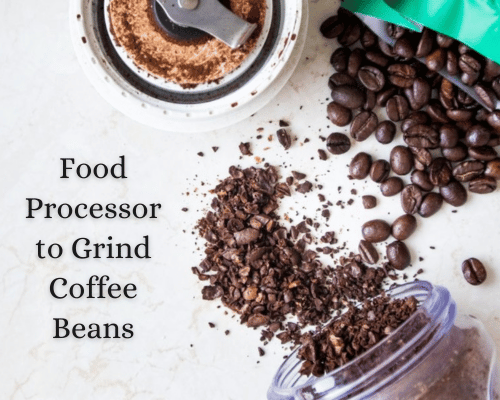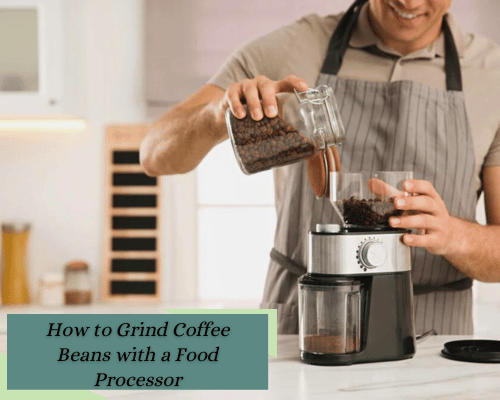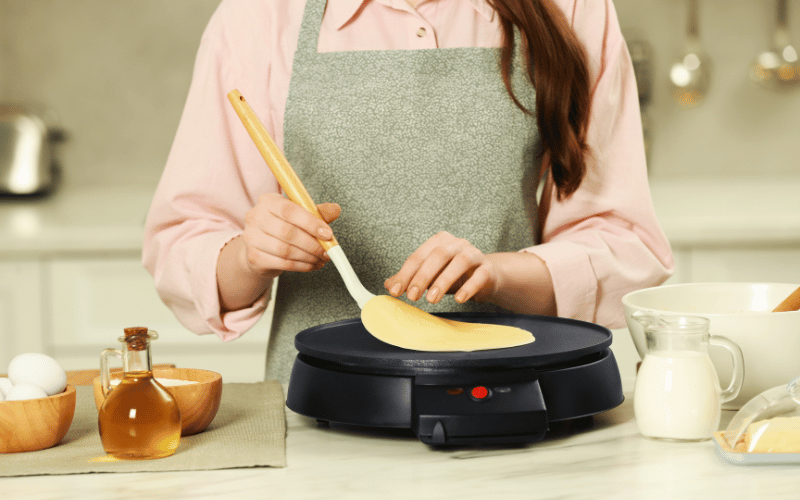In the realm of culinary experimentation, discovering the hidden potential of kitchen appliances can unveil a world of possibilities. One such query that often arises is: can you use a food processor to grind coffee beans? This question not only speaks to the curiosity of coffee aficionados but also highlights the multifaceted nature of kitchen tools. Understanding the versatility of these appliances transcends conventional usage, opening avenues for innovative culinary endeavors.
Table of Contents
In this article, we delve into the intersection of coffee culture and kitchen convenience, exploring whether a food processor can indeed serve as a viable grinder for coffee beans. From the basics of coffee grinding to the intricacies of utilizing a food processor, we aim to equip you with the knowledge and insights necessary to harness the full potential of your kitchen arsenal.
What are the Food Processors?
A food processor is a versatile kitchen appliance designed to facilitate various food preparation tasks with efficiency and precision. Its primary purpose is to automate and streamline processes that would otherwise require manual effort, such as chopping, slicing, shredding, pureeing, and mixing ingredients. Unlike blenders, which are primarily used for liquids, food processors excel in handling solid foods and offer greater control over texture and consistency.
Typically, a food processor consists of a base unit with a motor, a work bowl or container, and various attachments or blades. The motor powers the blades, which can be interchangeable to perform different tasks such as chopping, slicing, shredding, and mixing.
Food processors are invaluable for a wide range of kitchen tasks, including chopping vegetables, making sauces and dips, preparing dough for baked goods, grinding nuts or seeds, and even creating homemade nut butter or baby food. Their ability to quickly and efficiently perform these tasks makes them essential for home cooks and professional chefs alike, saving time and effort in food preparation while achieving consistent and reliable results.
Food Processor to Grind Coffee Beans

Grinding coffee beans is a crucial step in the coffee brewing process that significantly impacts the flavor and quality of the final cup. Whole coffee beans contain aromatic oils and compounds that contribute to the richness and complexity of coffee flavor. Grinding the beans exposes a greater surface area, allowing for the extraction of these flavorful compounds during brewing. The freshness of the ground coffee also plays a vital role in preserving its aroma and taste, as pre-ground coffee can quickly lose its flavor due to oxidation. Therefore, grinding coffee beans just before brewing ensures maximum freshness and flavor, resulting in a more satisfying coffee-drinking experience.
Coffee grind size varies depending on the brewing method and desired flavor profile. Coarser grinds are suitable for methods like French press and cold brew, where longer extraction times are used, allowing for a more robust and full-bodied flavor. Medium grinds are ideal for drip coffee makers and pour-over methods, striking a balance between extraction time and flavor clarity. Fine grinds, on the other hand, are necessary for espresso machines, where short extraction times require a finer grind to achieve optimal flavor extraction and crema formation.
Before the advent of modern coffee grinders, people used various traditional methods to grind coffee beans. One common method is using a mortar and pestle to manually crush the beans into a coarse powder. Another traditional approach involves using a manual hand grinder, also known as a burr grinder, which consists of a crank-operated mechanism to crush the beans between two abrasive surfaces. Additionally, some cultures employ stone mills or grinding stones to pulverize coffee beans into a fine powder.
Can a Food Processor Grind Coffee Beans?
Addressing the common question
One of the frequently asked questions among coffee enthusiasts is whether a food processor can effectively grind coffee beans. The short answer is yes, a food processor can be used for grinding coffee beans, but with some caveats. While food processors are primarily designed for chopping, slicing, and pureeing food ingredients, they can also be repurposed for grinding tasks, including coffee beans.
However, it’s essential to understand that food processors may not produce as consistent or fine a grind as dedicated coffee grinders. Despite this limitation, many people find that using a food processor for coffee grinding can still yield satisfactory results, especially for those who prioritize convenience and versatility in their kitchen appliances.
Factors to consider when using a food processor for coffee grinding
When using a food processor to grind coffee beans, several factors should be taken into consideration.
Firstly, the size and power of the food processor can affect its grinding capabilities. A larger, more powerful food processor may be better equipped to handle grinding tasks efficiently.
Additionally, the type of blade or attachment used can impact the grind consistency, with some blades better suited for achieving finer grinds than others. It’s also essential to consider the desired grind size and adjust the processing time accordingly to achieve the desired result.
Finally, proper cleaning and maintenance of the food processor are crucial to prevent cross-contamination of flavors and ensure the longevity of the appliance.
Potential advantages and disadvantages
Using a food processor for grinding coffee beans offer several potential advantages, including versatility, convenience, and cost-effectiveness. Food processors are multi-functional appliances that can perform a variety of kitchen tasks, making them a valuable addition to any kitchen. Grinding coffee beans in a food processor also allows for greater control over the grind size and texture, catering to individual preferences.
However, there are also some disadvantages to consider. Food processors may not produce as consistent or uniform a grind as dedicated coffee grinders, which can affect the overall flavor and quality of the coffee. Despite these drawbacks, many coffee enthusiasts find that using a food processor for coffee grinding can still yield satisfactory results, particularly for everyday brewing needs.
How to Grind Coffee Beans with a Food Processor

Step-by-step guide for grinding coffee beans
- Start by ensuring that your food processor is clean and dry.
- Measure out the desired amount of coffee beans based on your brewing method.
- Place the coffee beans into the food processor’s work bowl.
- Secure the lid tightly onto the work bowl to prevent any spills or accidents.
- Pulse the food processor in short bursts, rather than continuously running it.
- Check the grind periodically by stopping the food processor and inspecting the texture.
- Continue pulsing until you get the desired grind size, whether coarse, medium, or fine.
- Once satisfied with the grind consistency, turn off the food processor and remove the lid.
- Transfer the freshly ground coffee grounds to an airtight container for storage.
Tips for achieving the desired grind consistency
- Experiment with the processing time and pulse intervals to achieve the perfect grind size for your brewing method.
- Use smaller batches of coffee beans to ensure more uniform grinding and prevent overloading the food processor.
- Adjust the grind size by varying the duration and frequency of pulsing, aiming for a consistent texture throughout.
Safety precautions to keep in mind
- Always ensure that the food processor is unplugged from the power source before assembling, disassembling, or cleaning.
- Exercise caution when handling the sharp blades and moving parts of the food processor, especially when it is in operation.
- Avoid overfilling the work bowl with coffee beans to prevent strain on the motor and potential damage to the appliance.
- Keep fingers and hands away from the feed tube and other openings of the food processor while it is in use to avoid injuries.
- Allow the food processor to cool down before disassembling or cleaning to avoid burns from hot components.
- Follow the manufacturer’s instructions and recommendations for safe usage and maintenance of the food processor.
Frequently Asked Questions
Can all food processors grind coffee beans?
No, not all food processors are equipped to effectively grind coffee beans. The ability to grind coffee beans depends on factors such as motor power and blade design.
Will grinding coffee beans affect the flavor of other foods?
Yes, if the food processor is not properly cleaned after grinding coffee beans, residue can transfer to other foods and potentially alter their flavor.
How do I clean my food processor after grinding coffee beans?
Disassemble the food processor, wash the removable parts with warm, soapy water, rinse thoroughly, and allow all parts to air dry before reassembling.
Can I use a food processor to grind other types of beans?
Yes, a food processor can grind various types of beans, including lentils, chickpeas, and black beans. Adjust processing times for desired textures.
In conclusion, we’ve explored the potential of using a food processor to grind coffee beans, addressing common questions and offering practical tips. Remember to consider factors like grind consistency and cleaning procedures for optimal results. Embrace experimentation with your food processor, discovering its versatility beyond traditional uses. This journey highlights the adaptability of kitchen appliances, showcasing how they can elevate culinary experiences. So, next time you reach for your food processor, envision the endless possibilities it holds for enhancing your cooking adventures.

Hey There, I’m Monica, Mom of two. This is my personal blog site. Here I write about Kitchen Tips Tricks, Recipes, and Review the products I use.
I hope you enjoy the article. Give me feedback on how I’m doing with my blog. I would appreciate it so much.
Have a great day! 🙂
[Follow me on Twitter]


